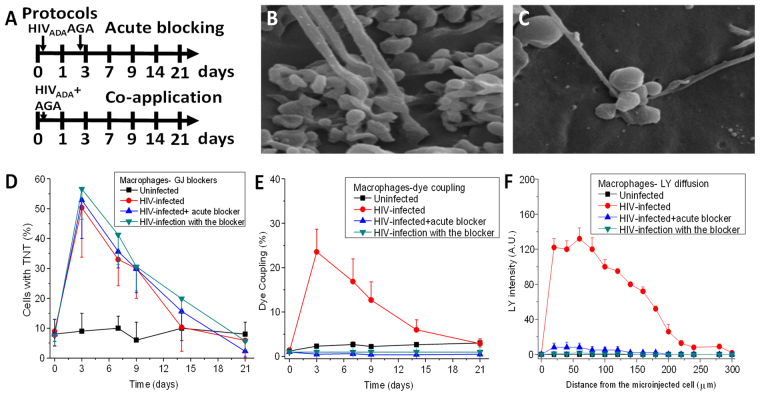Figure 3.
Gap junctions expressed at the tip are not required for the formation of TNT, but are necessary to establish the synaptic contact with the recipient cell. (A) A graphic description of both protocols used in our studies. Acute blocking protocol corresponded to HIV infection for 24 h and subsequent application of the gap junction blocker AGA after 3 days of infection. This protocol enables the virus to enter, integrate, and replicate for 3 days (protocol labeled acute blocking). In this case TNTs are formed, before the application of the gap junction blockers. The second protocol corresponds to co-application of HIV plus AGA (labeled co-application). (B) Under HIV conditions, a synaptic kind of interaction occurs between the cells forming the TNT and the recipient cell. (C) Both protocols using AGA, a GJ blocker, resulted in the aberrant formation of TNT-cell body interactions. The tip of the TNT process shows clear signs of swelling and aberrant cell to cell contact. (D) Time course of formation of TNT in uninfected (line with □), HIV infected cultures (line with •), HIV-infection with acute GJ blocking (line with ∇), and HIV-infection with the blocker (co-application, line with ◊). No significant differences in TNT formation were observed in all conditions (p ≥ 0.120, n = 4). (E) Time course of dye coupling in uninfected (line with □), HIV infected cultures (line with •), HIV-infection with acute GJ blocking (line with Δ), and HIV-infection with the blocker (co-application, line with ∇). Dye coupling evaluation shown that functional gap junctions at the tip of the TNT are required for effective communication between TNT communicated cells (all treatments were significant, except time point 0 and 21 days’ post infection, p ≤ 0.002, n = 4 as compared to HIV infection alone, red line). (F) Time course of LY diffusion from the microinjected cell into the TNT communicated cell in uninfected, HIV infected cultures (red line), HIV-infection with acute GJ blocking, and HIV-infection with the blocker (co-application). LY diffusion demonstrates that lack of proper formation of gap junctions at the tip of TNT compromise effective gap junctional communication (n = 3).

